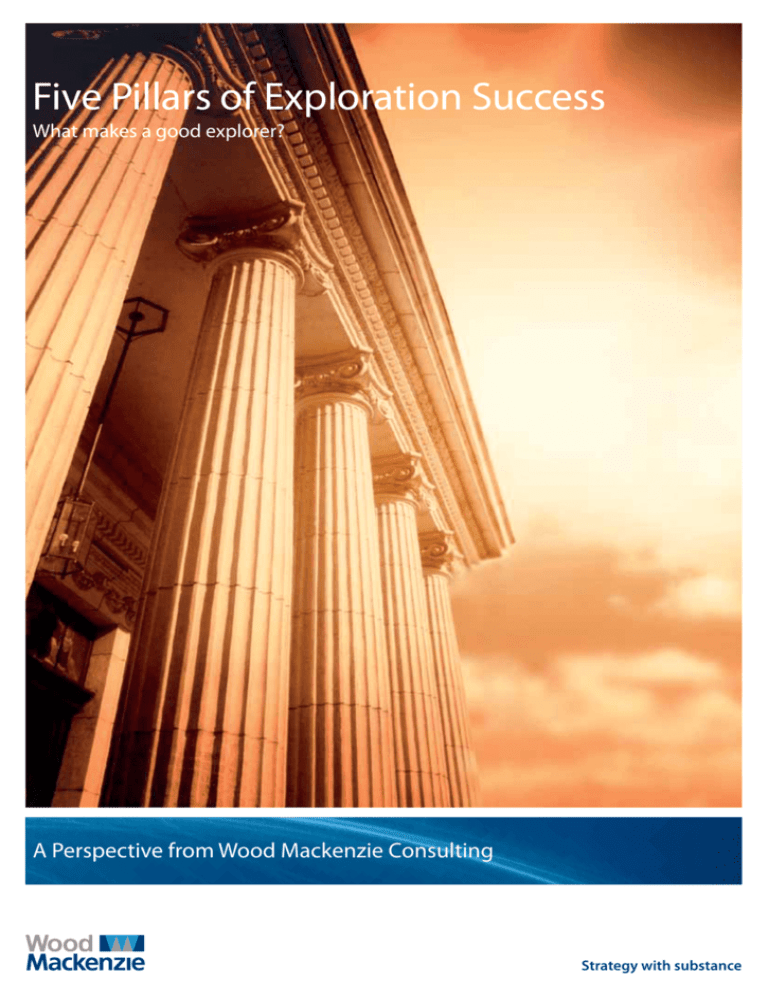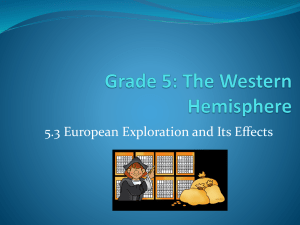Five Pillars of Exploration Success
advertisement

Five Pillars of Exploration Success What makes a good explorer? A Perspective from Wood Mackenzie Consulting Strategy with substance Introduction Basin choice is one of the primary determinants of exploration success. Optimal timing of basin entry is another. But how do the best explorers manage to consistently make better choices than their competitors? In our dialogue with the industry on the fundamental drivers of exploration outperformance, five broad themes arise that are seen as the pillars of consistently strong results: ›› ›› ›› ›› ›› Culture – the best explorers thrive on innovation and risk tolerance. They reward creativity, deal with subsurface and above-ground ambiguity, and nurture talent with the ability to originate new play concepts. Technical excellence – investment in technology innovation and skilful application of the best new technologies. Data and information – with organisational memory drawing on decades of exploration experience. Process and capital allocation – adopting sufficient rigour whilst neither stifling innovation nor introducing delay. Strategy – the best explorers have clarity of vision and goals, which are clearly articulated throughout the business. The most important of these five pillars is exploration culture. The manner in which an exploration organisation manages its people, skills and softer issues is the most difficult to get right. This means it is usually the key differentiator between exploration businesses. What makes a good explorer? The promise of higher returns than are typically achieved from other growth options attracts companies to invest in exploration. These superior returns – which have averaged 18% over the past ten years – are reward for those willing to accept and successfully manage the greater risks involved. For smaller companies, the possibility that success will also lead to transformational growth can make exploration even more compelling. Of course, there can be no guarantees. Exploration performance is amongst the most highly differentiated of upstream activities, with results varying widely from one company to the next. Each explorer takes the risk that its returns could be much lower than the attractive industry averages, or that its hopedfor growth fails to materialise. The emergence of unconventional plays has transformed the range of opportunities available. This greater complexity has presented new challenges to explorers as they work towards an integrated organic growth approach, and has triggered a re-assessment of exploration strategy for many. Much of our dialogue with exploration clients focusses on how the winners consistently achieve their stronger returns. Best practice in exploration can seem like healthy living, in the sense that much of it is obvious yet few adhere to all of the principles all of the time. Whilst there are no simple or universal rules, five general themes are apparent. The keys to exploration success usually lie within culture, technical excellence, access to information, process and capital allocation, and strategy. Figure 1 – Five pillars of exploration success Exploration strategy Process & capital allocation Technical excellence Data & information Exploration culture Innovation & risk tolerance are the foundations of exploration success January, 2013 | 2 Good explorers have a culture that embraces risk, innovation and creativity The best explorers have innovation and tolerance of risk at the heart of their organisations. They achieve this through the development of an exploration culture, which is quite different from other divisions. The challenge can be to sustain this distinctive culture whilst also remaining integrated and aligned with the broader company. Here, the buy-in and enthusiasm of the CEO and Board for exploration are critical to defining and nurturing the corporate culture. Risk tolerance has many facets. The key skills are dealing with ambiguity and seeing uncertainty as opportunity – balanced with a rational understanding of the likelihood of success and the cost of failure. The best explorers are comfortable with subsurface uncertainty, knowing that obvious prospects are often far too competitive. They tolerate aboveground risks when the geology is compelling. Part of their boldness is the willingness to take a chance, technically and politically, and to be wrong. Learning from failures is embedded in their culture. Innovation is the lifeblood of the best explorers. Management provides support for incubating new ideas. It is prepared to listen to weak signals and avoids accepting lowestcommon-denominator thinking. Many top explorers earmark part of their exploration budget for testing new concepts. Such creativity is encouraged and rewarded. An open-minded environment supports this culture. Individuals at all levels are comfortable to raise untested concepts, do not fear to be contrarian, and are encouraged 3 | January, 2013 with the sharing of ideas. The company is willing to entertain opportunities in basins where senior management may have experienced disappointment in previous decades. Equally, this willingness to listen to weak signals can also include rewarding those who spot problems in superficially attractive or popular opportunities. The requirement to identify and nurture individuals with a particular talent for innovation is a recurring theme. Perhaps less than one in ten geoscientists are the true innovators with the ability to originate new play concepts. The best explorers ensure that such people are in the right roles and are sufficiently empowered. Two issues commonly arise: ›› ›› The technical success of top innovators leads to their promotion into management roles. Many companies are adopting staff grade structures that allow parallel progress in technical roles to avoid this issue. Top innovators may be uncomfortable with process. Ideally, the most creative geoscientists are linked with experienced people to help let them out of the process when appropriate. One tactic for dealing with the natural tension between innovation and process is to buddy proven innovators with process ‘translators’. In this model, the innovator works closely with his or her process buddy, who then ensures that the idea is properly processed through the wider system. Good explorers are technically uncompromising The best explorers place great emphasis on subsurface geoscience and engineering excellence. This is a necessity given the increasing difficulty of discovering resources in ever more challenging reservoirs and environments. In this context, technology is an enabler, bringing invaluable tools but still requiring skilful application and knowledge to provide answers. Resource holders expect explorers to deploy the best technology available as part of their value proposition. This is true even though much of the best exploration technology is sourced from service providers rather than being developed internally. This non-proprietary technology may be regarded as commoditised. It is the appropriate application of technology that is the key differentiator. New technology can offer the chance to both open up new areas and to re-visit old ideas with a fresh perspective. Good explorers keep a particularly watchful eye on progress in development and production technologies. Any advances that might commercialise resources that were previously too difficult to exploit are of utmost interest. The lesson of ultra-deepwater was that much of the best exploration acreage was captured years before the production technology was ready. The same may now be true in many emerging lowpermeability plays, or in parts of the Arctic. Access to information and data is key Subsurface analysis is only as robust as the data and information upon which it is based. The best explorers invest substantially in their access to data and associated data and knowledge management systems. Many of the most experienced individuals are deployed in new ventures roles to draw on their wide previous experience. Collectively, this organisational memory represents Process and capital allocation – without stifling innovation or agility Exploration capital allocation depends upon process. The best explorers combine solid play analysis and rigorous prospect evaluation to bring discipline to their highgrading effort. Decision makers are armed with a view of opportunity size and risks that is standardised across their whole conventional and unconventional portfolio. Good explorers use process to balance their persistence with a play with knowing when to quit. They regard the understanding of dry holes as an important exercise, and see learning the reasons for each failure as an integral part of exploration. These processes are subject to regular review. Figures 2 and 3 illustrate post- often-repeated lesson is to avoid over use of commercial filters too early in the process, taking time to build adequate understanding of above ground challenges. Exploration processes are different from development processes. Technical rigour is required, but levels of uncertainty may be very high, making accurate assessment of risk difficult. In this context, one Process in itself cannot deliver success and has downside risks if used inappropriately. Process overkill can bring an exploration programme to its knees, with opportunities lost to Figure 2 – Example of dry hole failure analysis Seal/Retention Risk Factor Scale Timing/Charge 0.4 Structure Effective Reservoir 0.6 Migration Source Rock 0.8 Reservoir Type A B C D E Pre-drill risk assessment Pre-drill risk assessment and well failure reason Well failure reason not identified pre-drill Well F G H I 0.95 Cause of failure identified as largest pre-drill risk in 67% of dry holes (6 out of 9) Cause of well failure identified as significant secondary risk in a further 11% of dry holes Source: Wood Mackenzie This figure shows a generic example of the comparison of post-well failure analysis with pre-drill risk factors. Figure 3 – Example of post-well chance of success audit 0.16 1.0 0.9 Probability 0.14 Cum Probability 0.12 0.10 Actual discoveries = 55 Suggests P91 performance 0.8 0.7 0.6 0.08 0.5 0.06 0.4 0.3 0.04 Cumulative Probability Much of the focus on information access relates to technical data. But the best explorers also pay close attention to above-ground information. They recognise the need to avoid deploying their all-too-scarce geoscience talent investigating geologically-interesting but commercially unattractive rocks. At the same time, these explorers are alert to changes in above-ground factors, and any risks that they can mitigate, which potentially open up new opportunities. well audits of dry hole failure analysis and chance of success risking that potentially identify systemic bias to be addressed. Probability an invaluable source of knowledge that can be a genuine differentiator if leveraged correctly. The alternative is a form of ‘corporate amnesia’ that can lead to expensive repetition of past mistakes. Good explorers anticipate that they will benefit in the future from accurate recall of today’s learning, and capture and socialise their knowledge accordingly. The aging demographic profile of much of the industry reinforces this need. 0.2 0.02 0.1 0.00 0.0 0 5 10 15 20 25 30 35 40 45 50 55 60 65 70 75 80 85 90 95 Number of Discoveries Source: Wood Mackenzie This figure shows a generic example of the comparison of pre-drill probability of success estimates with well results. In this example, the company’s exploration programme has delivered more discoveries than forecast, suggesting its risking process may be too conservative. January, 2013 | 4 quicker competitors. Another danger is diminished personal responsibility. Individuals may feel that process constrains their freedom to try new ideas, causing frustration and lack of ownership in acreage and prospect decisions. Mindful of the above, good explorers recognise the importance of process, whilst also retaining flexibility and nimbleness for quick decision making when required. They make careful judgements if competitive pressures necessitate a compromise between process short-cuts and declining an opportunity because of insufficient time for full evaluation. This agility gives the best explorers the knack of adopting sufficient rigour whilst neither stifling innovation nor introducing delay. They use process to stop mistakes by drawing on corporate wisdom and ensuring sufficient scrutiny of important decisions. Flexibility is their key, protecting creativity whilst managing their portfolio of ideas. An integrated approach across all conventional and unconventional plays Increasingly, explorers need to consider unconventional plays alongside traditional conventional exploration activity, using an integrated process. Rather than treating unconventionals as discovered resources to capture and exploit, they are recognising that these plays carry risk and should be assessed and derisked accordingly. Mapping the conventional life cycle and risk concepts to unconventionals allows the consistent characterisation of all opportunities, and can provide a sound basis for efficient capital allocation. Wood Mackenzie defines Concept, Pilot, Ramp-up and Exploit 5 | January, 2013 life cycle stages for unconventionals, which broadly map to conventional assets as illustrated in Figure 4. Strategy – the best explorers have clarity of vision and clear goals An exploration business must understand its purpose and how this contributes to the wider enterprise. The best explorers can clearly articulate this vision, with leadership communicating specific goals for exploration to both the organisation and to investors. The commitment and buy-in of the Board and Chief Executive Officer are crucial. The best explorers enjoy corporate and investor understanding of the time and commitment that successful exploration requires. Critical to this is tolerance of exploration risk and the knowledge that failure is an unavoidable part of the process. A company must be able to take a longer term outlook, backed with consistency of exploration funding over several years at least. Without such vision and support, spending may be regarded as discretionary or dependent on short-term results, and exploration is unlikely to thrive. With top-level support, explorers can commit to the multi-year drilling programmes required in the world’s best basins, and can be confident of approval for campaigns to de-risk new play concepts. Clear goals inform explorers how their performance will be measured. Specific volume, cost or value targets can help set individual opportunities or prospects in context. These targets may be quite different from broader corporate metrics such as total shareholder return. These goals provide the basis for defining exploration strategy, illustrated by Figure 5. Good exploration strategy reflects any competitive advantages the particular company may have. These might be legacy positions in certain geographies, access to infrastructure, strategic partnerships, proprietary data and knowledge, or distinctive technical competencies. The best explorers leverage any such strengths that are their genuine differentiators. Alignment with the wider business is essential. Explorers create more value if they discover resources that fit with the overall business objectives and its strengths. Examples could be Figure 4 – Unconventional and conventional asset life cycles Conventional Asset Life Cycle Exploration Appraisal Development Production Unconventional Asset Life Cycle Concept Pilot Ramp-Up Exploit Source: Wood Mackenzie Perspective, “Shale vs. Big Exploration – what sort of risks are you taking?”, August 2012. Concept includes identification and leasing of prospective unconventional resource targets. Pilot includes de-risking with a drilling programme to establish repeatable, economically profitable results. Ramp-Up sees financing secured, rig fleets and completion crews contracted, leases drilled to hold, and midstream built-out. Exploit reflects development drilling to maintain production. large gas finds in the portfolio of an LNG player, or near-field discoveries capable of rapid development to address a short-term production need. Portfolio management is usually an important element of exploration strategy. The best exploration businesses know the ideal characteristics of the discoveries that they seek, and recognise that not every find will fit with portfolio ambitions. A willingness to divest such assets becomes a key part of the strategy. Lastly, for all that strategy is important, so too is a little bit of luck. The Board and investors might agree to a long-term exploration plan, but they often need some early results or indicators that the strategy is on the right track. The good fortune to have a quick success helps sustain their support, even if many such early wells are on acreage captured before any new strategy was put in place. In this context, it is tactical for explorers to diversify. Drilling sufficient wells across a diversified portfolio of opportunities in multiple plays helps ensure success. Oil is found in the minds of man* We conclude that the key to exploration excellence is people. The best explorers have a core of energised oil and gas finders with an empowered attitude. They form part of an integrated multi-disciplinary subsurface team that emphasises strong regional geoscience and fundamentals. Creativity is enhanced by greater diversity of backgrounds and cultures in the team. In this context, exploration culture is of paramount importance. Strategy, technical excellence, access to information, process and capital allocation are all necessary, but without the right culture are unlikely to deliver consistent exploration outperformance. It is ultimately the ability to encourage and harness the creativity of the most innovative explorers that is the key differentiator. Figure 5 – Example of exploration strategy bars used to understand and communicate changes desired High - impact Near - field Frontier Proven Diverse Focused Volume Value Early entrant Late entrant Operator Partner High working interest Low working interest Today Aspiration Strategic change desired Core regions Core competencies Oil Gas Long term Near term High AGR Low AGR Conventional Unconventional High subsurface risk Low subsurface risk Technically attractive Commercially attractive Today Aspiration Strategic change desired Source: Wood Mackenzie These show a generic example of exploration strategy bars highlighting aspired position versus current reality for a range of strategic themes. *After the pioneering petroleum geologist Wallace Pratt from his celebrated paper Towards a philosophy of oil finding (AAPG Bulletin, 1952): “Where oil is first found, in the final analysis, is in the minds of men.” January, 2013 | 6 Wood Mackenzie, through both its continued dialogue with the industry on the fundamental drivers of exploration outperformance and its research and consulting offerings advising clients on how to maximise value creation through exploration, looks forward to continued debate on best practice around these five pillars as companies grow both their conventional and unconventional portfolios. Wood Mackenzie’s consultants provide strategic advice based on real substance to clients in the global energy, metals and mining industries. We have been helping clients understand the energy and natural resource industries for four decades with industry leading research and are now leveraging that knowledge to offer advisory services across the energy value chain. With established presence in the Americas, Europe, Asia/Pacific and the Middle East, our consultants offer a truly global view for questions that must be considered in a global context. Authors Dr. Andrew Latham Vice President Exploration Service T +44 (0)131 243 4408 E andrew.latham@woodmac.com Dr. David Parkinson Lead Exploration Consultant T +65 6518 0861 E david.parkinson@woodmac.com www.woodmac.com/consulting Perspective content subject to copyright, which can be found at: www.woodmac.com/disclaimer 7 | January, 2013 Global Offices Europe +44 (0)131 243 4400 Americas +1 713 470 1600 Asia Pacific +65 6518 0800 Emailcontactus@woodmac.com Website www.woodmac.com Australia Brazil Canada China India Indonesia Japan Malaysia Russia Singapore South Korea United Arab Emirates United Kingdom United States Wood Mackenzie is the most comprehensive source of knowledge about the world’s energy and metals industries. We analyse and advise on every stage along the value chain - from discovery to delivery, and beyond - to provide clients with the commercial insight that makes them stronger. For more information visit: www.woodmac.com POJAN13 Global Contact Details







